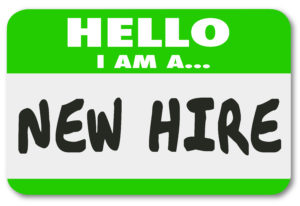I have had several conversations lately with HR Managers and their toils and troubles in the hiring, on boarding and the acculturation of their new employees. It seems we went a long time between the feast and the famine, so its important that our hiring and retention activities are intact.
I saw this article in the February 2019 Issue of “The HR Specialist.” It gives some pretty good advice and questions to ask your new employees.
Improve the On-Boarding Process
 With the economy on the rise, employees are finding it easier to leave jobs in which they’re not completely comfortable. That’s putting more pressure on HR and managers to improve the on-boarding process for new hires. (Also see the article on: “On-boarding: The First 90-Days.”)
With the economy on the rise, employees are finding it easier to leave jobs in which they’re not completely comfortable. That’s putting more pressure on HR and managers to improve the on-boarding process for new hires. (Also see the article on: “On-boarding: The First 90-Days.”)
The last thing an organization wants to do is restart the expensive hiring process because a new employee walked out after a couple of months.
Most Important Step
Talk with new employees soon after they arrive to uncover potential problems that can cause turnover. Don’t wait until performance or behavior shows problems – or for an official performance review. By then, the employee could be halfway out the door.
Make it a point to meet with new hires within the first 60 days. Start by reminding them that you are glad they’re part of the organization and you value their input. Then, ask some of the following questions:
1. Why do you think we selected you as an employee?
2. What do you like about the job and the organization?
3. What’s been going well? What are the highlights of your experiences so far? Why?
4. Do you have enough, too much or too little time to do your work?
5. How do you see your job relating to the organization’s mission?
6. What do you need to learn to improve? What can the organization do to help you become more successful in your job? (Be prepared. These questions may require follow-up.)
7. Tell me what you don’t understand about your job and about our organization.
8. Compare the organization to what we explained it would be like.
9. Which co-workers have been helpful since you arrived? (Goal: Pinpoint which employees can be influential in retaining the new hire.)
10. Who do you talk to when you have questions about work? Do you feel comfortable asking?
11. Does your supervisor clearly explain what the organization expects of you?
12. How does it go when your supervisor offers constructive criticism or corrects your work?
13. Do you believe your ideas are valued? Give examples.
14. How well do you get along with co-workers?
15. Have you had any uncomfortable situations or conflicts with supervisors, co-workers or customers?
Tip: Finish the discussion by asking employees if they have any questions for you or suggestions on how the job can be managed better.
The practice of asking these questions, once started, should be continued. Also, this process should be discussed with the other leaders within the organization so there is little to no fear you’re trying “to get them.”





